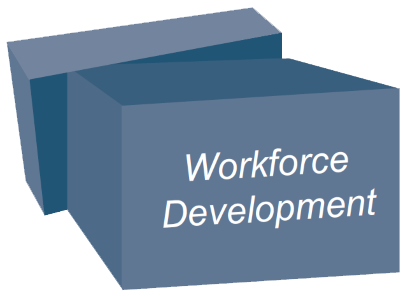Design
See an index of all documents from example states in the Library .
Consider Whether this Program In a Box is Right for Your State
To pursue a workforce development program, begin by asking whether your state seeks to expand the workforce of a particular energy industry sector, or to expand the overall industry labor pool. Some states may need to build their energy workforces of specific sectors in order to take full advantage of the Infrastructure Investment and Jobs Act (IIJA) and the Inflation Reduction Act (IRA). For example:
| Maryland OSW Workforce Training Program | New York OTJ for Energy Efficiency and Clean Energy Businesses | |
|---|---|---|
| Workforce Need | Targets a specific energy sector (offshore wind) poised for significant growth, that faces a trained worker shortage. | Targets existing businesses to subsidize on-the-job training. |
Justice40 Considerations
Through Executive Order 14008 which established the Justice40 Initiative, the Biden Administration has set a goal of ensuring that at least 40 percent of the benefits of federal investments flow to disadvantaged communities. Justice40 will have significant implications for hundreds of programs across the federal government, including clean energy, climate, and resilience programs that are overseen by the U.S. Department of Energy (DOE) in partnership with states. State Energy Offices and their partners may wish to consider assessing various dimensions of their programs – including such factors as the ability of disadvantaged and diverse individuals and communities to influence, participate in, and access the benefits of state policies and programs – and explore metrics and reporting strategies that will help illustrate the Justice40 impacts of their policies, programs, and investments. Available resources to support these actions include:
- White House landing page for Justice40
- July 2021 Office of Management and Budget Interim Implementation Guidance for the Justice40 Initiative
- Justice40 Initiative Updates from DOE’s Office of Economic Impact and Diversity
- Guidance on Community Benefits Plans in Proposals for IIJA Funding
- January 2023 Addendum to the Interim Implementation Guidance for the Justice40 Initiative, M-21-28, on using the Climate and Economic Justice Screening Tool (CEJST)
- Instructions for using the Climate and Economic Justice Screening Tool
Through NASEO’s Energy Equity Committee , State Energy Offices can learn about ongoing developments and resources that support federal Justice40 and state energy equity and environmental justice goals.
To help states identify the location of disadvantaged communities, the White House Council on Environmental Quality (CEQ) has developed The Climate and Economic Justice Screening Tool (CEJST) . Instructions for using the tool are linked above.
When designing workforce development programs, priority could be given to training centers or businesses that are located in, or serve, disadvantaged communities.
Goals and Name
Developing program goals is an opportunity to communicate to internal agency staff and external stakeholders the purpose and nature of the program — clearly and concisely. Updating the goal statement over time memorializes key changes to program scale, scope and details.
Naming the program is an important step in the process of branding and advertising.
Recommendations for a program name:
- Reflect the goals of the program
- Solicit recommendations from participating agencies and organizations
Performance Metrics
Program metrics should be defined before the program is implemented. Metrics to consider include specific equity and Justice40 goals, to measure impact on the participating communities.
Budget and Staffing
Before finalizing the program design, consider budget allocations and staffing requirements for agencies involved.
| Maryland OSW Workforce Training Program | New York OTJ for Energy Efficiency and Clean Energy Businesses | |
|---|---|---|
| Budget | $800,000 for FY23 | $15 million available through Dec. 2024 |
| Maximum Grant Award | $400,000 per applicant, not to exceed 75% of the total project cost | Business reimbursement rate varies by size of business, clean energy sector, and type of worker hired. Maximum funding per hire is $21,120. $150,000 maximum per business, with no cap on hiring from priority populations / disadvantaged communities. See Program Opportunity Notice 3982 for more detail. |
Eligibility Criteria
Clearly define which organizations and businesses are eligible to apply for workforce development funding.
| Maryland OSW Workforce Training Program | New York OTJ for Energy Efficiency and Clean Energy Businesses | |
|---|---|---|
| Eligible Recipients | Emerging businesses, nonprofits, state/local/municipal governments, higher education institutions | Businesses in the energy efficiency and clean energy sector, based on a defined eligible technologies list. |
| Allowable Funding Uses | Capital expenses to offset training center expansions and purchase of training equipment; and operating expenses for curriculum development, training materials and instructor salaries | Funding directly subsidizes a percentage of a new worker’s wage to reduce risks for businesses hiring new employees. Businesses can choose to use the funds to offset training costs or for employment recruitment and/or retention incentives. |
Program Administration
| Maryland OSW Workforce Training Program | New York OTJ for Energy Efficiency and Clean Energy Businesses | |
|---|---|---|
| Funding Administration | MEA staff announce annual solicitation, review, and awarding funding to applicants. | NYSERDA staff review applications on a rolling basis until funding/program expires. |
| Ongoing Programmatic Support | MEA staff work with grantees on developing grant agreements. | NYSERDA and NY Department of Labor staff work with participating businesses and hires to develop a training plan which outlines the skills and knowledge workers will learn on the job. NYSERDA staff provide payments to participating businesses on an ongoing basis. |

